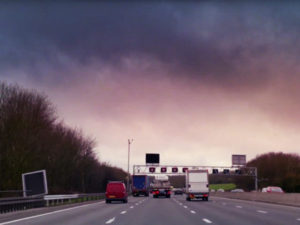Roll-out of smart motorways on hold amid safety concerns
No new stretches of smart motorway will be opened until the results of a government review on their safety come in, Transport Secretary Grant Shapps has announced.

The national roll-out of smart motorways is on hold until the results of the government review come in
Speaking to the Commons, Shapps said a £92m smart motorway section in Kent would not open to traffic while the dangers of the roads are being assessed as he added that the review – announced last October – had “uncovered a range of issues that I am not content simply to brush over.”
He said this put a halt on rolling out the network further until the “outcome of the stocktake” was in.
Shapps continued: “We must make them at least as safe, if not safer, otherwise they cannot continue. But we have to do this as a fact-based process. I am interested, rightly, in speaking to the families of the victims as well as to organisations such as the AA and the RAC and to Members of this House.”
Other smart motorways being worked on include stretches of the M62, M23 and M6.
While his comments have been welcomed by safety and motoring organisations, the RAC has pointed out that it’s nearly four years since a cross-party group of MPs called for a halt to the roll-out of ‘All Lane Running’ smart motorways.
Head of roads policy Nicholas Lyes continued: “This was ignored by the Government at the time, although some positive superficial changes were made to schemes. The fundamental issues of SOS area spacing and stopped vehicle detection raised four years ago remain. We very much hope the current review results in some meaningful changes that give drivers confidence in all aspects of safety on smart motorways.”
A BBC Panorama special aired last Monday (27 January 2020) revealed that 38 people have been killed on smart motorways in the last five years and that on one section of the M25, outside London, the number of near misses had risen 20-fold since the hard shoulder was permanently removed in April 2014.
The programme also found that features on the UK’s original smart motorway schemes, such as the dynamic hard shoulder on the M42 and M4/5, had not been carried over to today’s All Lane Running smart motorways, which have the hard shoulders now permanently removed and SOS areas spaced up to twice the distance apart.
Lyes continued: “The decision to make All Lane Running the default type of smart motorway happened without proper consultation, despite the concerns of the breakdown industry and emergency services.
“Troublingly, in 2020 we now have a hotchpotch of different schemes designed to different standards – a complicated and ultimately unsustainable situation. Short of reintroducing the hard shoulder, the introduction of the latest radar technology to detect stationary vehicles automatically, together with many more SOS areas and a large-scale public information campaign, should help make drivers feel more confident in the safety of the UK’s motorway network.”
Lyes continued: “A rethink in the design of smart motorways is clearly needed to bring consistency, reduce risks in breakdowns, and turn around plummeting public confidence. As it stands, we are not convinced that the current ‘All Lane Running’ design is working and have reservations as to whether it should be the de facto standard going forward.”
Neil Greig, IAM RoadSmart director of policy and research, also welcomed Shapp’s comments, adding: “Spending scarce resource on roads that may have to be upgraded again in a few months would be a complete waste of time and put drivers’ lives at risk.
“The focus must now be on quickly establishing what can be done to make existing smart motorways much safer. That must start with a programme to deliver the right detection technology and more frequent refuges, as well as safe completion of current ‘live’ projects.”
He added: “Extended education campaigns can also start immediately as well as greater enforcement of Red X violations across the network.”












